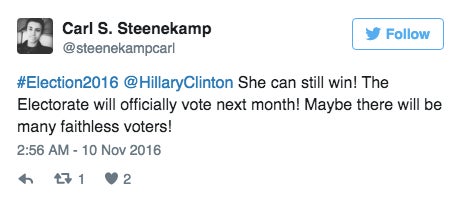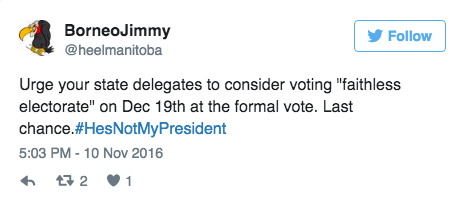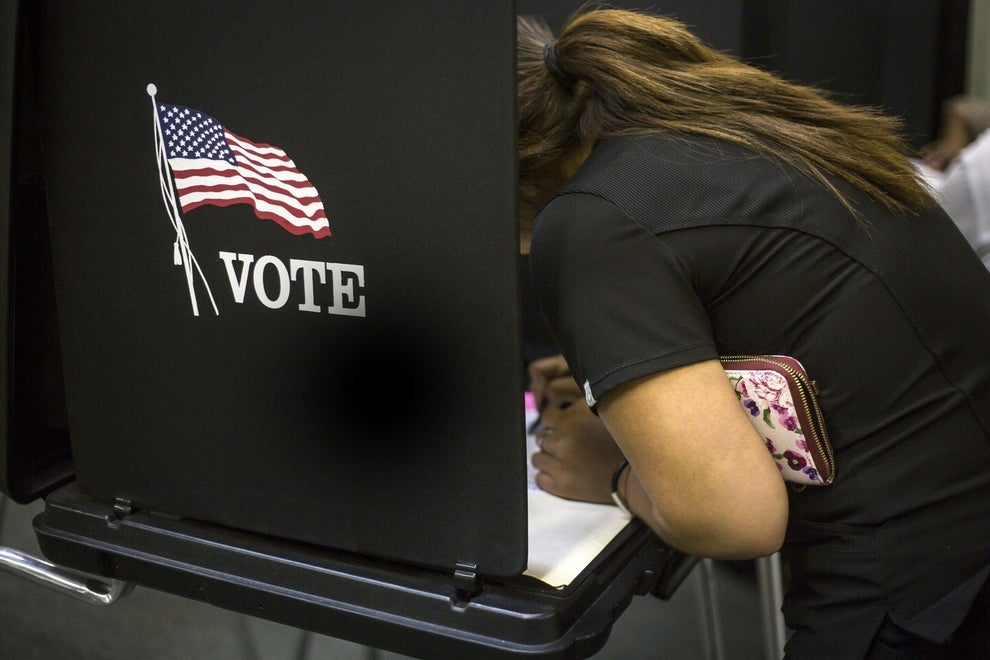
On Wednesday, a
theory began circulating online that if enough members of the Electoral
College in states that President-elect Donald Trump won either voted
for Hillary Clinton or abstained altogether, Clinton could win the
presidency.
Trump does not technically become president until the Electoral College votes on Dec. 19.
The theory came about, in part, because Clinton currently has about 230,000 more popular votes than Trump. But because Trump won more than 270 electoral votes, he became president-elect. His victory over Clinton has sparked a wave of protests across the country.
This is the fifth time a presidential candidate ultimately lost the race because they did not earn enough electoral votes despite having won the popular vote. The most recent instance was in 2000, when Al Gore lost to George W. Bush. It has also happened in 1824, 1876, and 1888.
A Tumblr page called ChonceGiving appears to be the first place this year where the idea that the college could vote Clinton into the presidency was posted.
The Tumblr post notes, for example, that “Trump won Pennsylvania, a state that typically votes blue, by less than 100,000 votes. While it is highly unlikely to get all 20 electoral voters to cross party lines and vote Democrat, it also isn’t impossible to convince a few of them to be ‘faithless electors.’ We only need to convince 38 out of the 166. That is 23%. There are sixteen states we need to focus our attention on.”

Trump does not technically become president until the Electoral College votes on Dec. 19.
The theory came about, in part, because Clinton currently has about 230,000 more popular votes than Trump. But because Trump won more than 270 electoral votes, he became president-elect. His victory over Clinton has sparked a wave of protests across the country.
This is the fifth time a presidential candidate ultimately lost the race because they did not earn enough electoral votes despite having won the popular vote. The most recent instance was in 2000, when Al Gore lost to George W. Bush. It has also happened in 1824, 1876, and 1888.
A Tumblr page called ChonceGiving appears to be the first place this year where the idea that the college could vote Clinton into the presidency was posted.
The Tumblr post notes, for example, that “Trump won Pennsylvania, a state that typically votes blue, by less than 100,000 votes. While it is highly unlikely to get all 20 electoral voters to cross party lines and vote Democrat, it also isn’t impossible to convince a few of them to be ‘faithless electors.’ We only need to convince 38 out of the 166. That is 23%. There are sixteen states we need to focus our attention on.”



The New York Post covered the theory Wednesday night, and it has since been picked up by several other news outlets. The Post’s story noted that “given the high dissatisfaction with Trump among Republicans, a few faithless GOP electors could well go rogue next month.”
It also cited a Politico story from August in which Texas GOP Electoral College member Chris Suprun — who represents the congressional district that includes Dallas, which was expected to and did vote for Clinton on Tuesday — claimed that he would consider casting his electoral vote for Clinton because he was skeptical of Trump.
The following day, Suprun told the Post that he would support his party’s pick on Dec. 19.
But the theory continues to gain traction on the internet, and one call to action on Change.org currently has more than 2.4 million signatures.
Here’s a brief history of the Electoral College.
 Ap Photo / AP Photo
Ap Photo / AP Photo
The Electoral College assigns a certain number of electors from each state, determined by population, to cast their vote for president and vice president based on how constituents voted.
It was a compromise between the popular vote and congressional selection of the president and vice president, but it also offered increased representation to white slaveholders in the South who were outnumbered by their white counterparts in the North.
The Three-Fifths Compromise, also established at the convention, allowed for enslaved black people to count for three-fifths of a person. This significantly boosted the population of Southern states, thus affording them more electorates.
Electorates in 21 states are not legally obligated to align with the popular vote; when they vote against that, they are called “faithless electors.” This has happened seven times in election history. But as noted by the History, Art, and Archives page of the US House of Representatives, faithless electors have never decided a presidential election.
Original proponents of the Electoral College argued that it would prevent a concentration of power in one region from dominating the election.
Meanwhile, critics’ biggest issue with the Electoral College is that it undermines the idea of each individual’s vote figuring directly into who becomes president.
It could also discourage voter turnout, especially in “safe states” that are all but guaranteed to align with a particular party. And because people of color tend to be concentrated in those states, their voting power relative to non-Hispanic whites decreases, according to a BuzzFeed News analysis.
And this is why the Electoral College theory won’t hold up.
 John Locher / AP Photo
John Locher / AP Photo
Even if the required electorates became faithless and voted for Clinton or abstained, resulting in a deadlock, the vote would then go to the House of Representatives.
Oklahoma Council Public Affairs fellow Trent England pointed out that the likelihood of electorates abandoning their party, much less members of the Republican-majority Congress, is incredibly slim.
“If enough Trump electors voted for Clinton, she could win the election,” England said. “If Donald Trump had won by one or two or maybe a half dozen electoral votes, that might be realistic, but he is going to end up winning by about 36 electors. And these are people who are party faithful.”
Historically, faithless electors have only taken action because they knew it would be symbolic and not have an impact on the election.
England added that this is precisely why the House, whose representatives are elected directly by voters every two years, is next in line if electorates enter an impasse.
“The Founding Founders wanted it to go to the House because they could easily be punished by voters if they’re found to do something illegitimate,” he said.
“Voters would find a scheme like this at this point in the process to be illegitimate. Politicians aren’t going to do something that will destroy their careers two years down the road,” he added.
Source:BuzzFeed News
loading...


 John Locher / AP Photo
John Locher / AP Photo












0 Comments
We Will Love to Hear From You! Pls Comment Your Views...........